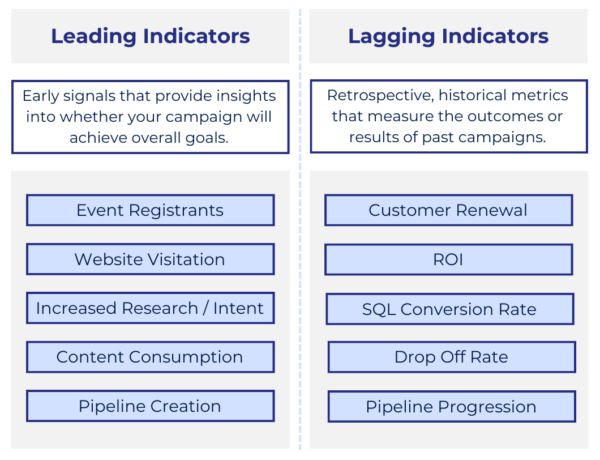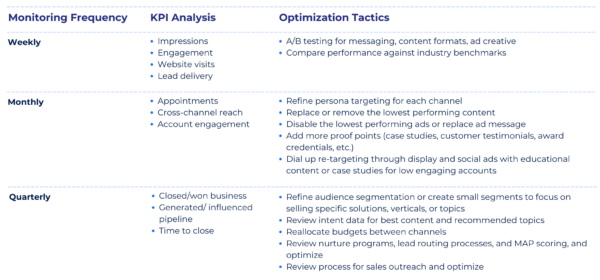
How to Measure and Optimize Your Campaigns Toward Success

Repeat after us: real-time strategy measurement and optimization are fundamental to campaign success.
As we enter another year where economic uncertainty continues to impact spending decisions, B2B marketers will be forced to rely more heavily on data to ensure they’re maximizing their budgets. A unified multi-channel account-based marketing (ABM) strategy provides the best view of account progression through the buyer’s journey, making it easier to identify trends, adjust strategies, and make data-driven decisions that will improve campaign effectiveness rather than waiting until the end to realize what went wrong.
Ready to start implementing a better measurement framework that enables you to visualize campaign performance and optimize your approach in real time? Read on to learn how.
Pay Attention to Both Leading & Lagging Indicators
Company size, growth stage, and industry marketing benchmarks will all impact how you align your campaign goals. Still, understanding foundational marketing and sales metrics, like customer acquisition cost, conversion rate, and deal velocity, and how each channel impacts them, reveals how successful your channels are in terms of engagement and where you can maximize results.
Breaking your marketing and sales metrics down into their leading and lagging indicators provides a deeper understanding of how your content and messaging is performing across campaigns.

While leading indicators contribute to your goals, they can fluctuate from campaign to campaign and month over month. On the other hand, lagging indicators take longer to measure and need more time before you can optimize against them. Since it takes time to see campaign impact on your lagging indicators, use your leading indicators as a sign as to whether you’re on the right track. You’ll want to gather historical data for both, but lagging indicators will be more quantifiable after going through your sales cycle two or three times.
Set Individual Channel KPIs That Roll Up into Campaign KPIs
Measuring campaign performance isn’t one size fits all. It’s important to set goals and measure success individually within each marketing and advertising channel. Success within an email program looks drastically different than success within a display program, but they’re all indicators of the overall health and success of your campaign.
Ideally, you measure each program on an ongoing basis with their specific KPIs, gather your findings into a monthly report, and tie all activities together into a full campaign readout. This helps you understand which channels are performing the best and how those channels impact lead scoring.

Understanding the success of your multi-channel strategy requires you to dive deeper into your data (which is hopefully already in a single, holistic view—more on that below) to determine how each channel impacts pipeline and revenue on an individual and collective campaign basis. And with your findings, you can then optimize each channel with content that not only fits your channel KPIs, but fuels conversations around how these metrics are indicative of a strong marketing strategy that fuels higher quality interactions that will ultimately benefit your company’s bottom line.
Measure Lead Quality During Nurture Stages of the Funnel
Throughout the nurture process, measure the quality of each lead you’re nurturing and any disqualification trends you identify. If you’re receiving out-of-market leads or a large drop during the nurture stage, analyze your initial targeting, channel, and content strategies, and optimize each strategy with your findings. You may also need to adjust timelines per channel, as algorithm and marketplace conditions may impact buyer behavior and the visibility of your campaigns.
Optimize KPIs for Personas in the Buying Committee
Your KPIs aren’t just a foundation for goals or focus to optimize your channels toward—they’re reactive to who you’re targeting in the first place. Buying committees aren’t set in stone and may change their initial point person or decision-makers for a variety of reasons. Ideally, your KPIs are aligned with each member of the buying committee’s role, as everyone’s impact on buying decisions is different. If you’re looking to get your foot in the door with new, inbound leads, adjust your scoring model to focus on the people who will take that initial call versus a buying committee member who will just have to sign off on the partnership.
One practice to consider is to measure the initial lead’s engagement with your engagement benchmarks, then drop the benchmark by 10% for corresponding buying committee members since they’re not as invested yet. Segment your findings according to similar accounts within the funnel and compare their behaviors with current and previous clients to consider what their buyer journey may look like. This practice will eventually plot out a timeline for leads initiating contact with or responding to a salesperson.
Prioritize Your Potential Advocates
When you think about how to divide your campaign efforts, prioritize the personas who will advocate for you. If you can deliver enough content and generate enough engagement with the personas who carry the most influence during the decision-making process, they’ll do the work for you to convince the rest of the buying committee that you are the right partner and tool to help them achieve departmental and company goals. Once you identify your advocates, consider their persona and optimize future campaigns around similar demographics.
Consider what forms prospects fill in as part of their buyer journey. High-intent forms include a demo request or contact form, while low-intent forms may be a webinar registration or eBook download. While leads can skip around funnel stages, moving from TOFU to BOFU content, they may potentially stall. One way to avoid sudden jumps around content is to map out content that easily complements each other. You can also take a more technical approach by A/B testing CTA copy, button placement on a landing page, and reading suggestions. Keep in mind that, with A/B testing, you only want to test one element at a time and measure it for a set period of time before optimizing everything across your website.
Measure Metrics Against KPIs on a Regular Basis and Optimize
Measuring and analyzing shared KPIs is crucial for understanding the effectiveness of your campaigns. With regular tracking, these metrics allow sales and marketing teams to identify areas for improvement, adjust tactics accordingly, and ensure all efforts are aligned and focused on delivering the best possible customer experience.

Connect ABM Campaigns with Your CRM/MAP to Enhance Visibility
Having a holistic view of your entire marketing performance data makes it easier to track and measure your campaigns with greater accuracy and efficiency. That’s why it’s important to connect your CRM and MAP with your ABM activation platform to use account-level insights to validate campaign influence on opportunity volume, deal value, and sales cycle velocity. This allows you to quickly identify trends and then optimize each channel with content that not only serves each metric, but also fuels conversations around how these metrics are indicative of a strong marketing strategy that fuels higher-quality interactions that will ultimately benefit your company’s bottom line.
Gain a Unified View of Multi-Channel ABM Impact with Madison Logic
Data-driven, multi-channel ABM is the most effective way to maximize budgets and improve operational efficiency. The ML Platform is the most efficient way to show you exactly how cross-channel campaigns impact your sales pipeline and revenue. It’s a single source of truth that demonstrates how accounts move through each stage of the buying journey and how that journey impacts ROI.
Get started with a more constant, repeatable measurement and evaluation framework for better visibility into campaign success and to identify areas for improvement. Request a demo to uncover the drivers of performance with your ABM strategy.
Interested in learning more about how this and other 2024 B2B marketing trends will impact or enhance your ABM strategy? Download our 2024 B2B Marketing Predictions eBook for more information about the developing trends shaping 2024 and what they mean for you.

